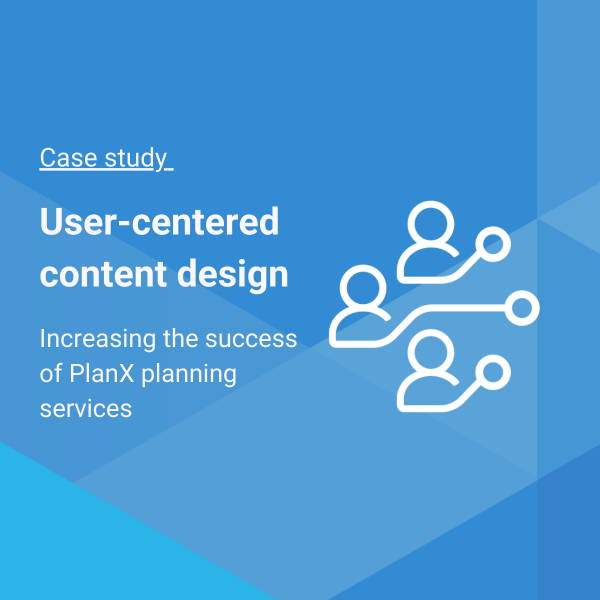Before the project kicked off
Once confirmed as an early adopter of the PlanX tool - Find Out If You Need Planning Permission - the council established a working group with colleagues from across departments. They recognised that the council’s planning pages on the website hadn’t been reviewed in some time. Updating this content was already on the digital team’s 2024 roadmap, but the introduction of PlanX services provided a central focus for improving the web content to make it as clear and user-friendly as possible.
By improving their existing content and aligning it with the advanced capabilities of PlanX, the team positioned themselves to deliver an excellent experience to users of their planning tools.
Assessing existing content
The council had recently switched to Google Analytics 4, Google’s latest web analytics tool. This project provided an opportunity to explore the tool's features while auditing current content performance using GA4 reports, including page views, landing page, traffic source, and user flow.
This audit identified issues such as:
- Pages with little or no traffic
- Content with high exit rates
- Pages with very low dwell time (where users arrived but didn’t engage)
The analysis also highlighted well-performing pages, including those with high traffic, effective landing pages, and pages that encouraged user actions - such as navigating further on the site, completing a form, or following an external link.
An SEO audit of the Planning and Building Control content was also conducted. This covered:
- How content ranked in search engines
- Whether content ranked for appropriate search terms
- A review of URLs and site structure (IA)
- Identification of pages competing against each other (e.g., duplicated content)
This audit was combined with insights from the customer experience team, who held internal and external workshops to assess content performance. Together, these findings identified areas where users struggled to find information. They also enabled the team to map user journeys, providing valuable insight into how users navigate the content.
Creating a project timeline
Using the SEO audit findings, along with digital analytics from Google Analytics 4, the council developed a new information architecture (IA) for the section. This structure reorganised existing content to better align with user needs or introduced new content to address previously unmet needs.
Content design process
The new pages in this section were written with user needs in mind, to be more user-friendly and adhere to Barnet Council’s style guide, which aligns with the Government’s Digital Service style guide. Existing content was rewritten to the same guidelines. First drafts of the new and rewritten content were created by a content designer who collaborated closely with a subject matter expert from the planning team.
User testing the new content
Once the new content was drafted in the updated style and placed within the new layout, the council recruited a diverse group for user testing. This group included planning advisors, members of the public interested in the planning application process, and individuals with no prior knowledge of the content.
A user testing script was prepared with key tasks designed to reflect the primary needs of users in this section. These tasks included:
- I am a householder planning an extension and want to find out about the planning permission process.
- I want to comment on an application for planning permission on my street.
- I want to find out about the work I can carry out on my property that may not need planning permission.
The success of the content was measured by how easily users could complete these tasks.
The results led to minor tweaks, language adjustments, and additional explanations within the content. These included:
- Expanding on what Planning Agents are.
- Clarifying what Pre-application advice is (and isn’t).
- Managing user expectations when linking out to separate organisations, such as the Planning Portal.
These changes were reviewed and approved by the council’s planning subject matter experts, and a publication date for the updated content was set.
Preparing for publication
As the new section included updated URLs, steps were taken to ensure users with bookmarked links wouldn’t encounter error pages. To address this, a set of URL redirects was implemented to seamlessly direct users to the updated pages.
Monitoring the performance of the new content
The council used Google Analytics 4 and Search Console to benchmark the performance of the previous content and assess the impact of the updates. These tools confirmed that the new content was meeting expectations by showing:
- User journeys were being followed: Defined user journeys were mapped across the new content, starting with an entry point (e.g., a landing page—the first page a user sees on the site) and ending when the user’s needs were met. End points included using PlanX, commenting on a planning application, and finding out about Permitted Development Rights. Page views and traffic flow data confirmed these pathways were being followed.
- Improved search performance (SEO): The new content appeared in Google search results for the correct terms. Previously, users searching for planning permission information were incorrectly directed to unrelated content, such as Barnet pages on commenting on applications. This issue was resolved, and relevant pages began ranking properly for targeted search terms.
- Improved traffic and engagement: Page views increased by 25% for some key landing pages, and Exit Rates decreased, indicating users were staying engaged and taking action.
In addition to tracking page views, satisfaction, and SEO scores, Barnet also monitored clicks to PlanX services from their website using Google Analytics 4’s Events metrics.
Six months after the content changes went live, Barnet’s planning pages are averaging a:
- 20% increase in page views
- 28% increase in monthly visitors
- 35% increase in visitors from search engines
